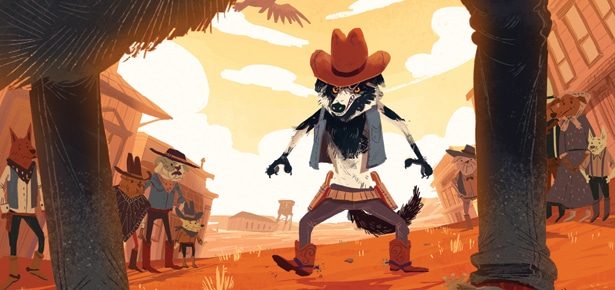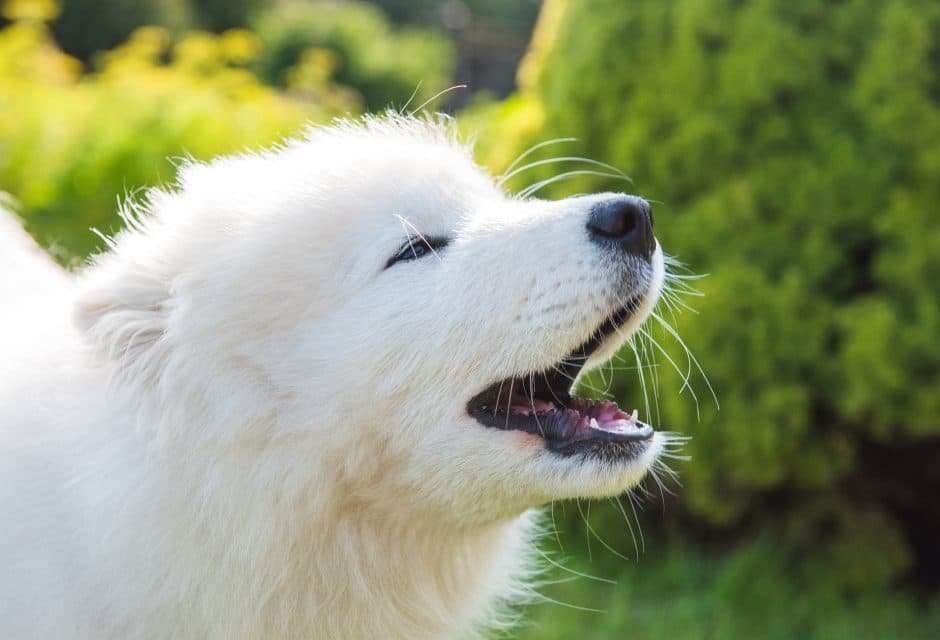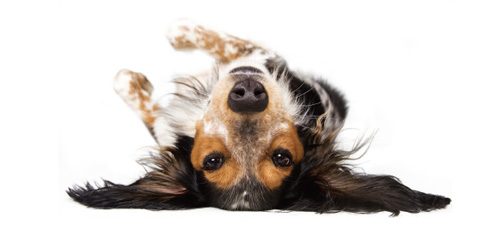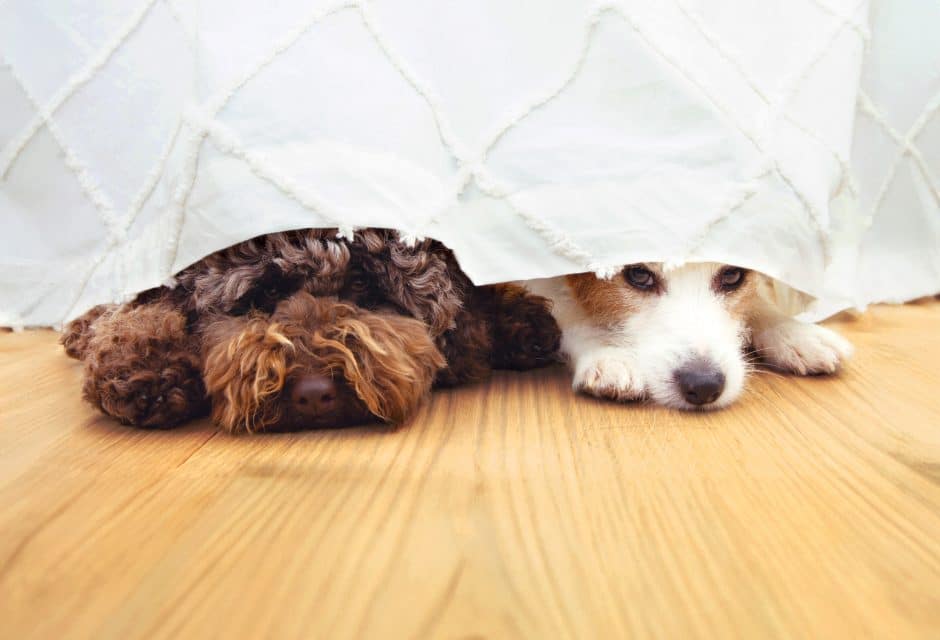

Doggie Détente
10 tips to manage your dog’s aggression toward other dogs
Everyone gravitates to Mary’s people-friendly Great Dane mix, Gloria. But toss another dog into the mix and Gloria morphs into a fire-breathing dragon, ready to pounce on the unknown canine, no matter the size, age or demeanor. And so poor Mary avoids other dogs like the plague.
The Stress of Dog-On-Dog Aggression
The anxiety that dog aggression evokes for well-meaning guardians cannot be understated. When you cannot confidently walk your dog in a place frequented by other dogs, you resort to skulking out at odd times, crossing streets to avoid conflict, or even not walking your dog at all. This “cloistering,” or avoidance of social situations, only magnifies the problem as your dog perceives your stress and interprets it as danger. Slowly, you become a slave to your own dog’s pathological hostility.
Why My Dog?
The causes of dog-on-dog aggression are often hard to determine definitively. Puppies taken from the litter too soon often do not experience enough social interaction with their siblings and can later on show a lack of sociability leading to aggression. Likewise, dogs who get attacked by other dogs can carry that fearful prejudice with them forever. Rescue dogs attacked in a shelter often learn to dread the sight of their own kind. And sometimes, a dog simply has a genetic propensity toward dog aggression. We often inadvertently teach our dogs to be wary of others. If you tense up and tighten your leash when other dogs come close, you’ll telegraph that lack of confidence right down the leash and into your pet, causing her to become suspicious and on guard. Pushy, poorly trained dogs can show a desire to bully other less assertive animals. For instance, a dog might, in vying for attention, fight off another dog. If not addressed, this behaviour can become an engrained problem.
Waging the Peace
Fortunately, there is much you can do to manage dog-on-dog aggression. Doing so, however, will require regular work on your part and a realization that your dog is a complex being with her own unique personality, history, and tendencies that cannot be changed overnight. But with patience and persistence, you can begin to get her to tolerate her own kind.
One caveat: if your dog has had a history of profound dog aggression, seek out the advice of your veterinarian and of a pet behaviourist experienced in dealing with aggression issues. Doing so may help prevent future injury or worse.
The 10 Tips
1. HEALTH AND TRAINING ESSENTIALS
Dogs tend to be stoic regarding pain; if confronted with a frisky young dog who wants to play, for instance, a dog with a sore paw might opt to lash out defensively rather than take the chance of further injury. Likewise, a dog with no baseline obedience rules to fall back on may take matters in her own hands and deal with any level of unwelcome interaction with aggression. Training builds confidence and trust; without them, your dog will often react instead of think.
Take your dog for a checkup every year and pay close attention to her overall health. Handle and groom her regularly to detect physical problems, thus making sure self-protection stemming from physical discomfort is not the source of her aggression. Also, be sure to train your dog and to maintain and augment that training to build confidence, trust, and tolerance.
2. REALISTIC SOCIALIZATION
Once removed from the shelter or litter, dogs often interact with other dogs only when visiting a dog park or daycare or on daily walks. These brief encounters often serve not as desensitizing social events, but as antagonistic confrontations often made worse by nervous people with tight leashes.
By all means, let your dog play and socialize. But avoid throwing him into situations where he gets overwhelmed by dozens of roughhousing, unpredictable dogs. Overcrowded dog parks with bullying dogs or daycares with many dogs in a small space have done more to breed dog-on-dog aggression than almost anything else, so choose a place with a reasonable number of friendly pets or enough room to provide plenty of spatial safety valves. Avoid forcing socialization; instead, adopt a more laid-back attitude and let the dogs come together in a more natural, less compulsory way.
3. ACCEPT YOUR DOG’S LIMITATIONS
Like people, dogs display a spectrum of personalities, from happy and eager to outright grumpy and antisocial. Breed, history, genes, upbringing—many factors contribute to make your dog who she is. It doesn’t mean that she can’t become more affable; it just means that sometimes you could be asking too much. Tossing your nine-year-old arthritic Chow Chow into a yard with two eight-month-old Labs, for instance, is probably asking for trouble. Instead, pair dogs of like personalities and ages, balance out genders if possible, and praise any friendly interactions. Avoid using toys or treats at first to prevent possessive aggression and step in often to mentor and focus.
4. USE CALM INDIFFERENCE
When around other dogs, many dog lovers adopt either an overly cautious, consoling attitude or else a frenetic, over-the-top persona. Both these guises can come across as threatening or insincere to many dogs, especially the unsure, nervous ones. Instead, project a confident, almost haughty attitude, one that says, “I’m comfortable here and have no worries.” This, instead of a consoling attitude or one filled with frenzied verbalizing, is the best way to build confidence.
5. PROPER GREETINGS
Most people have no idea how to greet a strange dog; they crouch down, reach a hand out, and, in the dog’s eyes, act like a threatening nutcase. Don’t do that, and don’t let others do it to your dog. Instead, greet the person first then have them walk beside you and your dog for a bit. Your dog will perceive that you are at ease and become accustomed to the person’s scent and presentation. At an appropriate point—say, when your dog is sniffing the person’s pant leg—have the person drop a treat on the ground. When the dog looks up for another, your friend can open-palm a second treat to her. Do the same yourself with dogs you see on walks.
When initiating greetings between your worrisome dog and another on-leash pet, the normal dog-dog greeting—a nose-to-nose, nose-to tail, play-posturing little ritual—should be replaced by a less confrontational technique called the “directed walk.” Instead of letting the dogs come face-to-face, simply fall in next to the other person, each of you holding your dog to your left, so that your four-wide formation is dog/person/dog/person. Walk briskly as a group and don’t allow contact—just a no-nonsense, directed walk, as if you are all on a mission.
After a block, do a wide about-face and continue on “the mission.” After a few minutes, with at least five feet of space between the dogs, have each sit, and reward with praise. Then repeat this, perhaps moving behind or in front, or even switching dogs. Do not allow them to actually greet until you have done this numerous times over several days. When you finally do allow them to greet each other, make it a brief nose-up only, followed by a new directed walk. The idea is to get your unsure dog to think there is something important going on that takes precedence over her fears. With dog-aggressive dogs, this “teaming” drill is a vital tool in desensitizing to other dogs.
6. USE THE RIGHT LEASH AND COLLAR
If you have a dog-aggressive dog, the right choice of equipment becomes vital to training and to preventing injury. No-pull harnesses do not allow control over your dog’s head, crucial in any aggressive situation. Face collars are not a good option either, as they can be slipped out of by a panicking dog, resulting in escape or unrestrained conflict. And, if a fight does happen and you need to pull your dog away, the increased leverage a face collar provides can result in a wrenched neck for the dog. Nor should a plain flat collar be used, as they can be easily slipped out of. The best option? Try a Martingale collar, a hybrid product that combines the security of a slip collar with none of the negative aspects. These tighten just to the point of snugness but no more, preventing both choking and escape.
Avoid extendable leashes when working your dog-aggressive dog. The ability to extend out as far as twenty feet from you puts your dog too far away for you to act in an emergency. And the possibility of the extended lead getting hopelessly tangled with another dog’s lead all but assures panic and conflict. Instead, stick with a standard leash.
7. MUZZLE WORK
Aggressive dogs use biting as a coping mechanism; if another animal approaches, a quick nip is all it takes to keep the “invader” away. Over time, this becomes the “go to” technique, preventing any chance of socializing. By fitting a quality nylon muzzle to a dog (the cage design muzzle can get tangled in a leash or come off), you passively take away that coping mechanism, and force the dog to use other methods to handle his fears. Placing a muzzled, dog-aggressive dog into a fenced yard with a friendly, confident dog can often be the fastest way to defuse aggression and get a dog socializing. Once the biter realizes he can’t use his mouth to cope, he’ll resort to body posture, growling, running off or chasing—all reasonable coping mechanisms. After several ten minutes sessions, most biters get the message and become tolerant of that one dog. Then, over time, you repeat the technique with a second dog, and then a third, and so on, until the aggressor realizes that he has friends for the first time in his life. These “friends” can then all be taken out on directed walks in public.
8. NEUTRAL TURF
While socializing your dog-aggressive dog, choose a neutral location away from any dog’s home turf. This will reduce the chances of territorial aggression. Avoid spots with big crowds or chaotic activity. A quiet park on a weekday is good; a weekend skateboard park, bad. And if you have any doubts, use a soft muzzle, as described above.
9. LIMIT THE EFFECTS OF TREATS, TOYS, AND KIDS
Minimize the chances of food or possessive aggression by limiting the use of food or toys when within twenty feet of any other dog or person. Avoid taking kids with you during these initial sessions to prevent the chance of a protective, parental reaction by your dog.
10. TIMING OF ASSOCIATIONS
When socializing your aggressive dog near other dogs, it’s vital for you to praise or correct her at the right moments. If she sits on command while five feet from another dog, quickly and enthusiastically praise her. Likewise, if she shows aggression or ignores a command, avoid praise, say “No,” and walk her off a few yards. Any reward must be timed properly; reward when she is starting to snarl or sneer, for instance, and you’ll end up praising the undesirable behaviour. So watch her carefully and reward only when she is showing no aggression.
With the right management skills along with patience and persistence, you can teach your anti-social dog to tolerate the presence of others of its own kind. In time, an amicable détente can develop, allowing your dog to face her fears, and express her innate canine desire to socialize and bond.
This article originally appeared in the award-winning Modern Dog magazine. Subscribe today!
Join the newsletter and never miss out on dog content again!
"*" indicates required fields
By clicking the arrow, you agree to our web Terms of Use and Privacy & Cookie Policy. Easy unsubscribe links are provided in every email.





